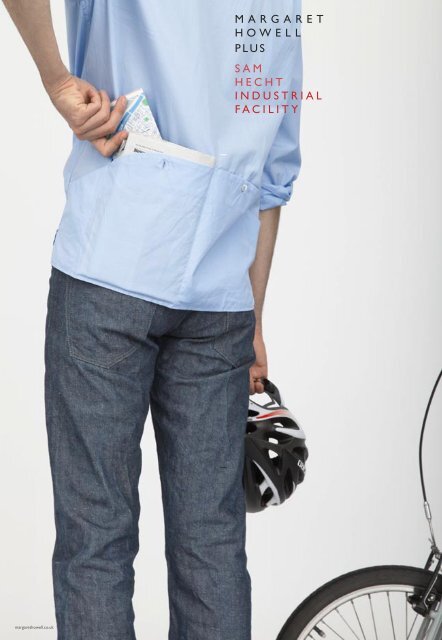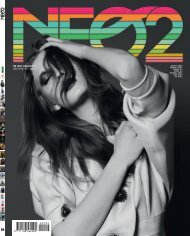Layout 2 - Industrial Facility
Layout 2 - Industrial Facility
Layout 2 - Industrial Facility
You also want an ePaper? Increase the reach of your titles
YUMPU automatically turns print PDFs into web optimized ePapers that Google loves.
MARGARET<br />
HOWELL<br />
PLUS<br />
SAM<br />
HECHT<br />
INDUSTRIAL<br />
FACILITY<br />
margarethowell.co.uk
SAM<br />
HECHT<br />
INDUSTRIAL<br />
FACILITY<br />
Sam Hecht and Kim Colin<br />
founded the London design office<br />
<strong>Industrial</strong> <strong>Facility</strong> in 2002. They<br />
have developed a range of<br />
projects in the areas of furniture,<br />
electronics, consumer products,<br />
fashion and interiors. Their work<br />
is in the permanent collections<br />
of museums around the world.<br />
<strong>Industrial</strong> <strong>Facility</strong> believes that<br />
design should simplify our lives.<br />
They practice rigorous investigation<br />
and analysis to achieve this,<br />
concerned not just with the detail,<br />
make and function of an object,<br />
but also the place where it will<br />
spend its life.<br />
Sam Hecht trained at the Royal<br />
College of Art, defining a personal<br />
style with interests in both<br />
industrial design and architecture.<br />
Travel to California and Japan led<br />
to early collaborations with Naoto<br />
Fukasawa and IDEO.<br />
Although Hecht is probably best<br />
known for his work with Muji –<br />
the ‘Second Phone’ and ‘City in a<br />
Bag’ – <strong>Industrial</strong> <strong>Facility</strong>’s products<br />
also include the re-working of<br />
Robert Welch’s ‘Chantry Knife<br />
Sharpener’, the third generation<br />
‘Picturemate’ printer for Epson,<br />
and the ‘Branca’ chair for Mattiazzi.<br />
<strong>Industrial</strong> <strong>Facility</strong> also works with<br />
Herman Miller, Yamaha, Established<br />
and Sons, and Issey Miyake.<br />
<strong>Industrial</strong> <strong>Facility</strong> has won many<br />
awards. It held its first exhibition<br />
in London at the Design Museum<br />
in 2008.<br />
In the same year Hecht was<br />
awarded Royal Designer for<br />
Industry (RDI) by the Royal<br />
Society of Arts.<br />
A selection of products designed<br />
by <strong>Industrial</strong> <strong>Facility</strong> will be on sale<br />
at our Wigmore Street shop.<br />
Top row (left to right)<br />
An Alarm watch<br />
— Idea<br />
Bell clock<br />
— Idea<br />
Branca chair<br />
— Mattiazzi<br />
Chantry modern sharpener<br />
— Taylors Eye Witness<br />
IF4000 bread knife<br />
— Taylors Eye Witness<br />
Below row<br />
Jet Lag travel clock<br />
— Idea<br />
Enchord table & storage<br />
— Herman Miller<br />
Beam lights<br />
— Established & Sons<br />
Table, bench, chair<br />
— Established & Sons<br />
Knife rack & IF4000 chef S knife<br />
— Taylors Eye Witness<br />
MARGARET<br />
HOWELL<br />
PLUS<br />
SAM<br />
HECHT<br />
INDUSTRIAL<br />
FACILITY<br />
This is the second in a series of<br />
collaborations with designers<br />
from other fields whose work<br />
Margaret particularly admires.<br />
This time her partner in the<br />
making of a unique shirt is Sam<br />
Hecht of <strong>Industrial</strong> <strong>Facility</strong>.<br />
‘Shirts are like people – a simple<br />
basic form, but with infinite<br />
variations of detail that make<br />
individuality. Adaptable and<br />
versatile, the shirt accommodates<br />
a variety of life styles, from shortsleeved<br />
leisure to starched-front<br />
formality.<br />
Faced with this variety, how<br />
do shirt designers go about their<br />
work?<br />
Successful design combines<br />
vision with craft. How these are<br />
balanced – and there are many<br />
ways – gives the designer their<br />
own signature. For me, a shirt<br />
has always been about the tactile<br />
quality of cloth and the detail –<br />
pocket, pleat, buttons. The life<br />
of a piece of clothing starts with<br />
its purpose, but its character lies<br />
in these details. As people are<br />
attracted to other people by their<br />
special features, so are they drawn<br />
to a garment. I have customers<br />
who tell me they love their shirts<br />
too much to throw them away,<br />
however worn or torn.<br />
Working with Sam Hecht was easy<br />
and pleasurable. Partly because<br />
we share a similar approach to<br />
design, paring away the inessential<br />
to find the purely useful, but also<br />
because it was clear from the<br />
start Sam knew exactly what he<br />
wanted. A prolific designer of a<br />
wide range of products, his vision<br />
was for a shirt to reflect his<br />
lifestyle – busy and urban, with<br />
much of it spent on two wheels.<br />
Sam took a shirt, then took it<br />
apart. Why not, he said, turn up<br />
the tail to make back pockets?’<br />
— MARGARET HOWELL 2011<br />
‘My discovery of Margaret<br />
Howell’s clothing has been<br />
a joyful surprise.<br />
That Margaret herself has a<br />
burgeoning curiosity about the<br />
modern condition, about how we<br />
live for simple pleasures, honest<br />
materials, the kind of authenticity<br />
which people always want to<br />
come back to – is something we<br />
share and that motivates me too.<br />
It seemed reasonable to design a<br />
shirt that appears familiar but also<br />
reflects how people are moving<br />
around the city these days.’<br />
— SAM HECHT<br />
INDUSTRIAL FACILITY 2011<br />
The result is a pale blue cotton<br />
shirt, pre-washed, with minimal<br />
front detailing. The back detail is<br />
inspired by turning up the tail of<br />
a classic shirt to create a divided<br />
pocket. An extra pocket on the<br />
left sleeve can hold a travel card.<br />
This is a shirt for both cycling<br />
and wearing in the work place.





